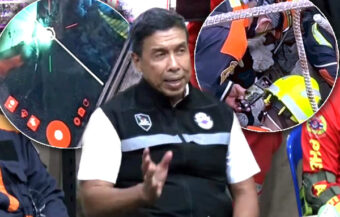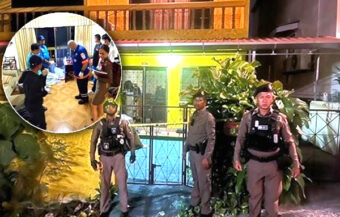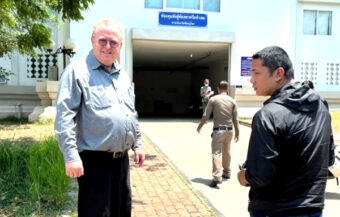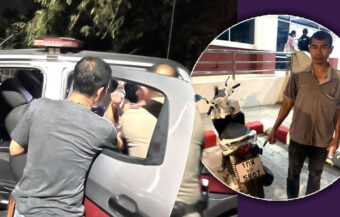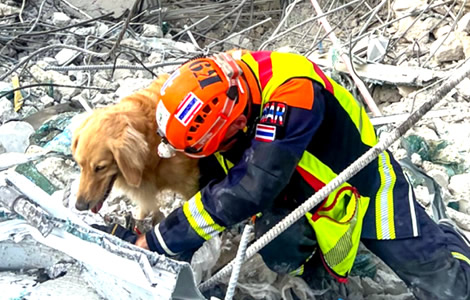PM orders arrests within 7 days over Chatuchak building collapse as police probe forged signatures, faulty shaft design, substandard steel and corruption, while seismic risk fears rise and state agencies face pressure to cooperate fully with investigators.
Prime Minister Paetongtarn Shinawatra on Friday ordered arrests be issued within 7 days against all wrongdoers related to the collapsed Chatuchak building. Later, however, Police Lieutenant General Somprasong Yentham suggested an extension to the timeframe may be required. Nonetheless, Prime Minister Paetongtarn signalled on Friday that serious legal action against all parties found at fault must be taken. She promised that the government would not let go of this important matter. Indeed, she told reporters that it is impossible that there will not be people found at fault given the scale of the disaster. At the same time, the deaths at the Chatuchak disaster site demanded justice.
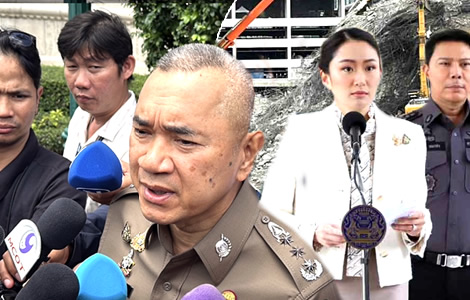
On Friday at 10 am, Prime Minister Paetongtarn Shinawatra held a summit at Government House with officials and senior police officers. At length, the PM wanted to hear firsthand how investigations into the disastrous collapse of the new Auditor General office in Chatuchak, Bangkok were progressing.
Top police officers certainly were in attendance including Royal Thai Police Chief General Kittirat Phanphet. In addition, there was Metropolitan Police Bureau Deputy Commissioner Police Major General Noppasin Poolsawat and Assistant National Police Commissioner Police Lieutenant General Somprasong Yentham.
Senior police, forensic experts and DSI brief PM on collapse including Chinese contractor under scrutiny
Simultaneously, officers with the Department of Special Investigation (DSI) were there to update the PM led by Director-general Police Major Yutthana Praedam. The meeting was also attended by senior police officers dealing with forensic analysis.
For instance, experts including Police Major General Wirun Supasingsiripreecha, Commander of the Police Hospital’s Institute of Forensic Medicine, and Police Major General Watee Atsawutmangkur from the Central Institute of Forensic Science, indicating the crucial role forensic work is playing in the case.
Afterwards, PM Paetongtarn confirmed that she had received a full briefing on all elements of the wide-ranging investigations. These include probes into Chinese contractor China Railway No.10 (Thailand) Ltd, owned by the Chinese state-owned China Railway Group (CREC).
Furthermore, the investigations are also looking at design flaws in the building. In particular suspicions about an outside wall and the construction of the elevator shaft. The shaft located at the centre of the building may have been out of balance. At the same time, it may also have lacked steel reinforcement.
Earthquake theory reviewed as shaft design fault may explain building collapse at its core or centre
Certainly, these are technical matters that are presently being reviewed. Deputy Prime Minister and Ministry of the Interior Anutin Charnvirakul on Friday spoke about the elevator shaft.
He suggested that a structural imbalance like this may have led to torsion at the height of the earthquake on March 28. Of course, this is still also a theory. Indeed Mr Anutin said that it must be proved scientifically and with mathematics.
PM Paetongtarn has meanwhile instructed the Department of Public Works and Town & Country Planning to fully cooperate with the police.
In particular, she requested that any personnel previously involved with the design or approval of the structure be excluded from investigative committees to ensure impartiality. She has also asked for documentation from the Comptroller General’s Department.
In essence, this will be used to evaluate material procurement standards and confirm if there was justification for contract termination. Notably, on January 20, the Auditor General reportedly moved to cancel the building contract. In turn, the contractor deployed extra workers.
PM and police now probing forgery allegations and illegal shaft changes without proper reinforcement
At length, even the flawed design theory is tinged with further criminality and corruption. In short, the engineer who signed off on the adjusted elevator shaft claims his signature was forged.
This individual is also presently a member of the Senate. Somkiat Chusaengsuk later made a complaint to police about the use of his name.
After that police are in the process of reviewing all architects and design engineers involved in the project. Certainly, this includes public officials.
The Prime Minister confirmed that the investigation includes the modification of key structural components such as the Core Wall — the wind shear wall critical in tall buildings — and the elevator shaft design. It is suspected these were altered without the necessary structural reinforcement, contributing to the collapse.
At the same time, the Prime Minister on Friday confirmed that prosecutions will be undertaken in relation to materials used in the project. Significantly, these include criminal prosecutions over alleged substandard steel and concrete.
Urgent inquiry into the use of substandard materials and potential fraud in procurement and contracts
She also stressed the urgency of identifying whether these materials were knowingly used below standard, possibly connected to fraudulent procurement practices and bid rigging. The DSI is pursuing legal action against parties involved in those decisions.
Finally, PM Paetongtarn told reporters that the lives of those killed in the disaster demand robust action. The PM said that from March 28, she had asked why only one building had fallen out of all of those in Thailand. The building collapse now looks like it has claimed 94 lives with no one found alive subsequently in rescue operations.
In the meantime, she made clear also that she has asked the Meteorological Office for an up-to-date report on earthquakes.
At length, there is some suggestion among experts that Bangkok in particular may be more at risk from Myanmar’s Sagaing fault. It is suggested that the March 28th earthquake represented a shift in the activity of this fault.
Bangkok may face greater seismic risk from Myanmar’s Sagaing fault according to earthquake experts
In part because of its alluvial soil, the Thai capital was already more susceptible to seismic activity. Indeed the concern is over the heightened risk from this fault, the capital’s soil and the trend to build more high-rise buildings.
“I would like to assure the public that the government has not let go of this matter and has no plans to let go. I cannot accept that people have died because of one collapsed building. But I understand if there is an earthquake like in Myanmar, where the earthquake was widespread and severe, it cannot be prevented. But this time, there was only one building. I have been saying since the first day that there was only one building, and I am following this matter seriously,” the prime minister said.
She also disclosed that four leading academic institutions are now working with the Department of Public Works to create a physical model of the building to determine the root cause of the collapse within 90 days. The study will explore possibilities including seismic vibration, strong wind force, and building material failure.
Meanwhile, on Friday Prime Minister Paetongtarn also promised that arrest warrants would soon be issued. In short, legal action for criminal acts would be undertaken by the state against everyone found at fault according to the evidence.
State prepares to launch criminal cases as PM demands cooperation and arrests from key agencies
She reiterated that while she is aware many agencies are busy, delayed cooperation — particularly from the State Audit Office — has impeded investigators’ access to vital documents including those pertaining to the cancelled contract and internal assessments. The Prime Minister warned that a lack of full cooperation would raise public suspicions and could trigger even further scrutiny.
Afterwards, Assistant National Police Chief Police Lieutenant General Somprasong Yentham was the target of reporters. The senior officer was tasked with having arrests warrants issued within 7 days.
Certainly, Police Lieutenant General Somprasong confirmed this. He would in turn communicate with all investigations. This comes as they are presently still collecting evidence.
At a press briefing at 11:50 am, Police Lieutenant General Somprasong acknowledged that seven days might not be enough and that the timeline could be extended if investigators required more time to gather evidence.
Arrests to follow evidence regardless of office or rank as design approval and oversight under review
In particular, he was asked by reporters if arrest warrants would only relate to controversy over the building’s design. Furthermore, would thuis also include employees and executives of the Auditor General’s office who had ultimately approved the design?
The senior officer would only say that arrests will follow the evidence. In brief, against all parties where police agencies have found wrongdoing.
He clarified again that at this time the timeframe is seven days. However, if an extension on this was required, it could be granted.
He emphasised that no group would be excluded. Even those responsible for design approval, budget authorisation, and final acceptance of the building would be scrutinised. He added that the number of arrest warrants was not yet finalised. Indeed, questioning continued across multiple agencies under the Building Control Act, including checks on whether inspections were properly conducted.
PM pledges accountability and calls for tighter rules for public building safety to prevent a repeat event
Lieutenant General Somprasong also cautioned the media. While he undertood reporters were eager for updates, further details could only be shared after sufficient legal evidence was gathered. After that, any resulting arrest warrants must be approved by the court.
When asked whether the investigation could finally bring accountability in a way that satisfies the public, the Prime Minister was clear. She responded that it was implausible no one would be held accountable.
Chatuchak building disaster finds more dead with major questions soon to be asked about Chinese firms
Chinese steel firm linked to Chatuchak disaster faces DSI probes. Minister cancels investment status
She acknowledged there are likely multiple failures at different stages. From design to approval to oversight and that each would be investigated on its own merits.
Furthermore, she called for stricter scrutiny over all large-scale government construction projects in the future. This was required to avoid any repeat of such a tragedy. The PM stressed the shared responsibility of public and private sector builders to ensure the safety of the people.
Join the Thai News forum, follow Thai Examiner on Facebook here
Receive all our stories as they come out on Telegram here
Follow Thai Examiner here
Further reading:
Chinese steel firm linked to Chatuchak disaster faces DSI probes. Minister cancels investment status
Storm clouds gathering over Chinese firm at the centre of the collapsed Chatuchak building disaster
US scan shows 50-60 human beings said to be in a hallway within the collapsed Chatuchak building
People’s Party on campaign but on guard against potential legal complaints to oversight agencies






